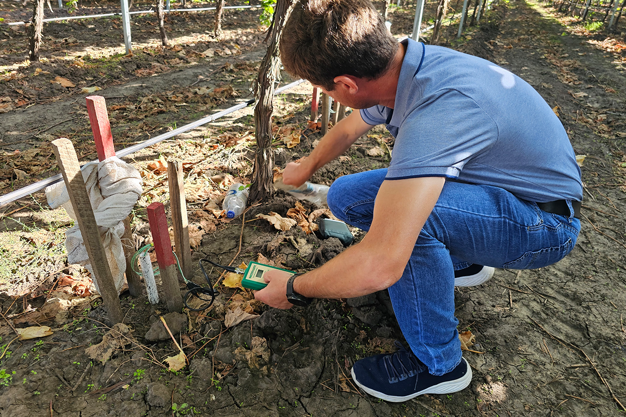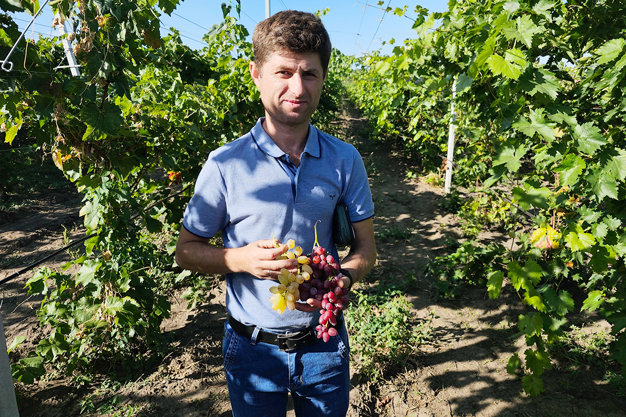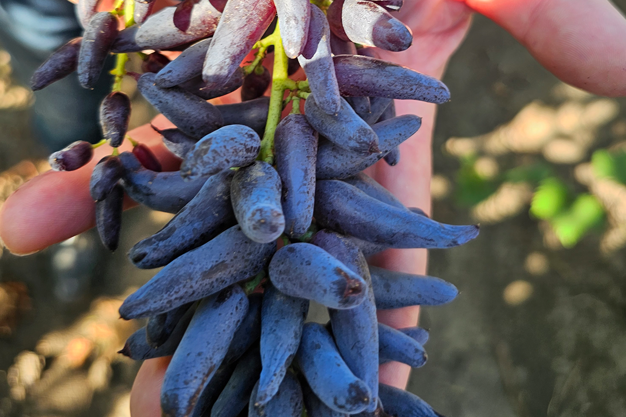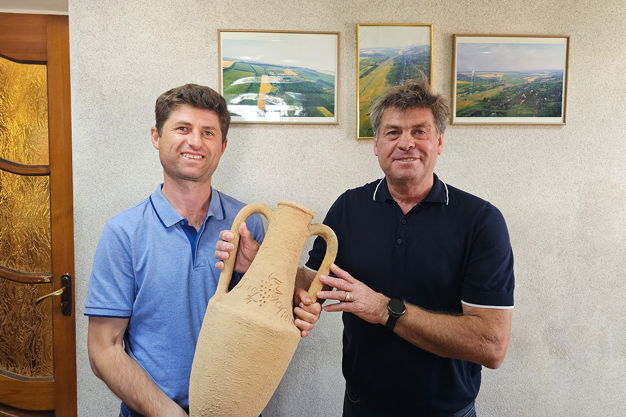In the south of Moldova, not far from the Romanian border, grapes are grown that produce some excellent wines, though these are sadly hardly known in Western Europe. That is where Terra Vitis has a sizable vineyard. By early September, in the week before Storm Boris hit, the company had already brought 180 tons of early white grapes to the fresh market and had started harvesting the sweet black Moldova variety. "We supply wine grapes to wineries, and the table grapes, we export mainly to Romania, Poland, and the United Kingdom," begins CEO and founder Petru Mihov.
By 2002, when Petru founded Terra Vitis, he already had years of experience in agri- and horticulture. In the final years of the Soviet era, he was the cultivation manager of the sovkhoz, a collective state farm, in his village of Burlacu. It spanned 5,000 hectares and was tended to by 3,000 people. Besides wine grapes, the farm grew grains and raised livestock.
Determined to stay
In the early 90s, after Moldova's independence and return to the free market, all state-owned farms were privatized, and each family was assigned an equal piece of land. Petru threw himself and all his skill into building a cultivation business, then on 300 hectares. That has since grown to 2,000 hectares. In 2024, his village is still home to 1,700 people. Almost half have moved away over the years in search of better opportunities, but Petru, his son Dumitru, and daughter-in-law Varvara are determined to stay. The business is doing well, and their dream, in the company's wake, is to gradually return the village to its past vibrancy.

"To know if and how much to irrigate, we have placed sensors in the soil at 30 and 60 cm," says Dumitru.
Irrigated versus non-irrigated grapes: a huge difference
Terra Vitis' vineyard spans 40 hectares and produces about 700 tons of fruit annually. Where the grapes are irrigated, they can harvest up to 35 tons per hectare. The non-irrigated section achieves a yield that is three times lower. "We keep adding irrigation and hail nets. But that, of course, is costly, about €50,000 per hectare. To know if and how much to irrigate, we have placed sensors in the soil at 30 and 60 cm," says Dumitru.
They cultivate Cubani, Dunav, Arcadia, and Prezentabil grapes, but the main variety is the Moldova, a native black, pitted grape. It thrives in the country's southern climate and has a flavor quality that can compete with the world's best grapes. Only, the market demands mostly seedless grapes.

Dumitru showing two varieties they are testing
Testing plenty of varieties
"Naturally, we spoke to licensed grape breeders, but I suspect the time isn't yet right to grow these in Moldova," says Petru. "Besides, our cold winters don't suit some seedless varieties. Varietal renewal is easier in apples and plums, but we're not letting that stop us. We're testing no fewer than 197 varieties, including some seedless ones. Most of these are of Moldovan, Ukrainian, Russian, and Bulgarian origin, varieties adapted to our growing conditions."
"To expand our range, we, along with a Moldovan research institution, are searching for economically viable varieties. That involves considering a multitude of factors, including plant failure, resistance to cracking, productivity, compactness, taste, market preferences, and the marketing window. Ukrainian Livia is an option, as is Alvika, which, even without a net, tends not to crack. We're enamored with the Velika and Sofia from Bulgaria. There are a few more, like a grape we first called witch fingers, then sweet drops or funny fingers, so as not to scare the target audience - children - too much," Petru further explains.
Moldova grapes getting better prices
Still, for now, the Moldova remains the most profitable variety. "Our region's day and night temperatures differ vastly, so this dark grape's flavor quality is undeniable. The marketing window is another plus. Picking begins on September 1, and since you can keep this grape in cold storage for three to six months, marketing continues through February. Russia and Belarus used to be our main markets, but the focus has now shifted to Poland and Romania. The only issue with this grape is that it's not in the high-price segment. That has purely to do with reputation. But demand has risen sharply over the past three years, as have prices, from about €0.60 to €1.40 per kilo."
In the packing facility, which includes two pre-cooling areas and storage cells for 600 tons, the wooden crates with plastic inner lining to protect the grapes are neatly stacked. They use IFCO crates for Romanian retailers, where the grapes are then repackaged at destination.

Funny fingers
Top fruit and cherries
In early September, Terra Vitis packages pears, too, specifically the Rx12-47 variety, similar to the Lucas. You can eat it either soft or hard, and it has no trace of bitterness. These are sold locally and in Romania. Xania and Vastovocinaia varieties complete the average 500-ton harvest. Although they also have ten hectares under apples, Petru says the country's south cannot compete with the north, where apple growing conditions are much better.
Cherries, on the other hand, thrive in the slightly warmer south, though Terra Vitis focuses on the extra early and early varieties. "No Kordia or Regina for us, but Bigarreau Burlat, Rocket, Techlovan, Grace Star, and Taina. We begin harvesting as early as May 29. And although we're well equipped with nets to cope with rain and hail, we picked the cherries early this year, before the heavy rains that damaged the later varieties that grow a little further north in the country. We harvest some 200 tons per year, and, this season, our cherries made their way to Poland, Romania, and the United Kingdom," explains Dumitru.
Labor is the biggest cost
Despite the ever drier and warmer summers, Terra Vitis' challenges do not necessarily lie with water availability - it has self-built reservoirs it fills, in the winter, from a nearby river - but, rather, with labor availability. "We employ 150 people year-round but obviously need more during harvesting. For arable farming on 1,800 hectares, we only need 15 people; fruit growing, though, is much less mechanized and thus requires more hands. At almost a third of the total, labor is our biggest cost. We do try to invest in machinery whenever possible, also because good labor is increasingly difficult to find. We may well have to bring in pickers from other countries in the future," Petru admits.
And, even though fruit farming is more labor-intensive, it is slightly more profitable than agriculture. "Plus, I'm proud that we can offer work to local people. I was born here and have lived here all my life. I feel connected to this village," concludes the man who organizes soccer matches for his employees, wants to provide the village church with a bell tower, and is proud of the coat of arms he designed for the village.
Petru's versatility is evident by his herd of 450 cows and flock of 600 sheep. Moldova must have been known for its tasty meat even in ancient times because a few years ago, an intact Greek amphora was unearthed on Terra Vitis land. After the National Museum examined the relic, it was dated to 360 B.C., from Heraklion. Back then, Greeks traded with nomads roaming north of the Black Sea. They exchanged products like oil and jarred wine for meat. But, these days, Moldovans no longer need to import Greek wine; the country's own fermented grape juice tempts many a wine lover.

Dumitru and Petru holding a replica of the Greek amphora they found on their land
Terra Vitis is GlobalGAP and GRASP certified and will be at the upcoming Fruit Attraction in Madrid. You can find the company at the joint Moldova Fruct sector organization's stand, 10D18.
For more information:
Varvara Mihov (Sales Manager)
Terra Vitis Ltd
Burlacu (Cahul) – Moldova
Mob: +373 608 10 215
[email protected]
